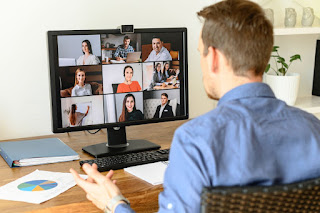It’s not just you: Zoom fatigue is a real thing. — Dreamstime/TNS
Covid-19 pandemic has moved our lives into a virtual space. Why is that so exhausting?
The tiredness doesn’t feel earned. We’re not flying an airplane, teaching toddlers or rescuing people trapped in burning buildings. Still, by the end of the day, the feeling is so universal that it has its own name: Zoom Fatigue.
Stanford University professor Jeremy Bailenson, founding director of the Stanford Virtual Human Interaction Lab, has some answers.
In research published Tuesday in the journal Technology, Mind And Behavior, he describes the psychological impact of spending hours every day on Zoom, Google Hangouts, Skype, FaceTime, or other video-calling interfaces. It’s the first peer-reviewed article to analyze zoom fatigue from a psychological perspective.
There are four major reasons, according to Bailenson, that video chats make us so weary. And he proposes some easy fixes.
We’re too close for comfort
Think of the normal meeting. You might be looking at the speaker. Or maybe you’re noticing those fancy new window blinds, your colleague’s weekend tan or the traffic on the streets below.
But on Zoom calls, everyone is staring at everyone, all the time. And our faces can appear too large.
When so many faces are so close to ours in real life, our subconscious takes it personally. It tells us: They either want to pick a fight, or have sex.
“
What’s happening, in effect, when you’re using Zoom for many, many hours is you’re in this hyper-aroused state,” according to Bailenson.
Solution: Exit out of the full-screen option to shrink face size. Use an external keyboard to create a comfortable space between yourself and the masses.
We really hate watching ourselves
For most of us, that quick morning glimpse in the mirror is all we really need. After hours of self-gazing, we turn critical.
We notice that sloppy shave job. The overdue haircut. The dead plant over our left shoulder. Or maybe the light’s all wrong, casting deep shadows, and we look like a member of the witness protection programme.
“It’s taxing on us. It’s stressful,” said Bailenson. “There are negative emotional consequences to seeing yourself in a mirror.”
Solution: Use the “hide self-view” button, which you can access by right-clicking your own photo, once your face is framed properly in the video.
We’re trapped in a chair
Humans are restless creatures. During phone calls, we like to wander around. Even if stuck at a meeting at a conference table, we find ways to stretch – leaning back in a chair or gazing pensively at the ceiling.
But with videoconferencing, we’re limited by the camera’s narrow field of view.
This is both physically and mentally deadening. “There’s a growing research now that says when people are moving, they’re performing better cognitively,” Bailenson said.
Solution:
An external camera farther away from the screen lets you doodle, release neck tension, do a seated twist or fidget, just like you do in real meetings.
Turning video off periodically during meetings is a good ground rule to set for groups, creating a brief nonverbal rest.
We can’t see body language, so it takes more energy to communicate
At their best, meetings can act like subtle symphonies, with everyone harmonising their postures, laughter and knowing glances. We read each other’s cues. Conversations have rhythm.
Not so with Zoom. There’s a rigidity, with only one speaker at a time. We must listen closely for sentence completion, so we don’t interrupt. To make an important point, we must add drama and flair.
“If you want to show someone that you are agreeing with them, you have to do an exaggerated nod or put your thumbs up,” said Bailenson. “That adds cognitive load as you’re using mental calories in order to communicate.”
Solution: During long stretches of meetings, give yourself an “audio only” break.
Don’t just turn off your camera – turn your body away from the screen. Gaze at that wall that needs painting, or the birds outside the window. Maybe hang up a few clothes, even wash a few dishes.
Want to measure your own Zoom fatigue? Because so many organisations – including schools, large companies and government entities – have reached out to Stanford communication researchers to improve videoconferencing setups, the team responded by devising the Zoom Exhaustion & Fatigue Scale, or ZEF Scale, to help measure workplace exhaustion.
The goal is to help change video technologies, so stressors are reduced.
To take the survey and participate in the research project, click here. – The Mercury News/Tribhttps://www.thestar.com.my/tech/tech-news/2021/02/24/new-research-why-zoom-can-wipe-you-outune News Service
Related
Zoom shares rise on strong current-quarter forecast, upbeat results ...

Related posts:
Block out background Zoom noise
Bothered by the background noise of Zoom calls? Here’s how to block it out






